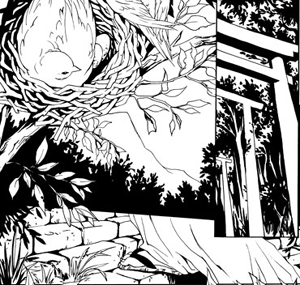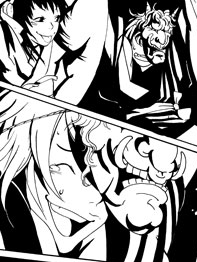Webcomics and global manga (the au courant term for manga created outside Japan) go hand in hand. One of the very first global manga, Megatokyo, is a webcomic, and many of the first Tokyopop generation — Queenie Chan, Svetlana Chmakova, and Rivkah Greulich posted their work on Wirepop back in the day (you can still find early works by Queenie and Svet there, along with hilariously out-of-date bios).
So I wasn’t too surprised when I heard that the winning entry in Kodansha’s Morning International Manga Competition, Kage no Matsuri, started out as a webcomic. The artist, who goes by the name rem, pulled it off the web when she entered the competition, but Kodansha plans to put it back online eventually. In the meantime, they have posted the runners-up, Nigiri Supahero and Vefurrin as webcomics, and both are interesting and odd in their own way.
Curious about how an online comic came to win an international competition, and how Kodansha is using the web to showcase global manga, I interviewed both rem and Eijiro Shimada, the editor-in-chief of the manga magazine Morning Two, via e-mail. I want to thank Yukari Shiina for translating my questions and Mr. Shimada’s answers.
Interview with rem: Creator of Kage no Matsuri
Since finishing Kage no Matsuri, which was written by the singly-named Bikkuri, rem has moved into print and is the artist for Vampire Kisses, which is based on the young adult novels of Ellen Schreiber.
 How did you get interested in comics, and when did you begin drawing in the manga style?
How did you get interested in comics, and when did you begin drawing in the manga style?
I’ve always loved comics ever since I was 7 or 8 years old, I’d say it came from my love of video games and Disney cartoons. When I was 10 I was introduced to my first manga, Ranma 1/2, and I’ve loved the style ever since.
What is Kage no Matsuri about?
Kage no Matsuri is a short story about a young man’s encounter with a oni girl. The oni witnesses an act of simple kindness on the man’s part and chooses to invite him to a secret yokai festival deep in the forest.
Why did you decide to put it on the web?
I wasn’t going to at first. I meant for it to be printed as a doujinshi one day, but in the end I decided that putting it on my website would be best.
What sort of reception did it get?
Well, no one said much about it at first. I think that it’s a little hard to talk about, actually, so I wasn’t surprised. Recently I’ve been getting very positive feedback, though.
Did your readers give you useful feedback?
I’d say more encouraging feedback, definitely. Everyone really complimented the yokai’s designs, and that made me really happy to hear.
What made you decide to enter the Kodansha competition?
 It was a very last minute decision. I heard about the contest early, but I was in the middle of working on Vampire Kisses and had no time to come up with an original work. So I thought about entering KnM because I REALLLY wanted to enter. I wasn’t sure if it qualified since it was already on my website but I was encouraged that Kodansha simply meant that the piece had to have never been published in print. So since I had nothing to lose if it didn’t qualify, I went for it.
It was a very last minute decision. I heard about the contest early, but I was in the middle of working on Vampire Kisses and had no time to come up with an original work. So I thought about entering KnM because I REALLLY wanted to enter. I wasn’t sure if it qualified since it was already on my website but I was encouraged that Kodansha simply meant that the piece had to have never been published in print. So since I had nothing to lose if it didn’t qualify, I went for it.
How does it feel to be the grand prize winner?
It’s pretty dumbfounding! The folks over at Kodansha have been so kind to me. I really am so grateful for this opportunity!
Now that you have a longer comic in print, Vampire Kisses, can you talk a bit about the differences between working on a fairly short comic for the web and a longer one for print—in terms of planning and the actual work?
Holy crap, it’s like the difference between night and day for so many different reasons. I mean, Vampire Kisses could not be any more different than KnM. Mainly because it’s not my story at all, and I don’t really communicate with the writer. Bikkuri (the writer for KnM) and I are very close so it’s kinda like his stories are my stories, too, and I get to put in a lot of input as a result. In KnM, I was totally free to do whatever I wanted and experiment artistically how I wanted. In the case of Vampire Kisses, everything is restrained and scrutinized by a ton of different people. The planning and actual work for VK was (is still) daunting since I am very new to the industry. I also hear that people who publish original titles are given much easier schedules that what I have. Everything is in steps: thumbnails, sketches, inks, and then toning, and each step needs to meet the demands of Harper Collins. So even though it was fun, and it still is, I feel like it’s a commission rather than my own work.
Interview with Eiijiro Shimada: the editor-in-chief of the manga magazine Morning Two
Why did you think the readers of a Japanese manga magazine would be interested in non-Japanese manga?
Generally speaking, the Japanese manga readers have very strong "chin" and "stomach" to digest and consume manga. As long as the manga is interesting, they’ll get fascinated in regardless of the creator’s nationalities. The Japanese manga readers might get interested in the personalities and mentalities of the artists, but they are likely not to be interested in their national backgrounds.
What sort of reaction have you had from readers?
I got responses from the Japanese manga readers that they feel a little bit sad that the Japanese culture is taken away by other countries. Some might feel that way at first, but in the long run I believe that "manga is taken away from other countries " is a good thing to the Japanese manga readers as well as manga readers outside Japan.
I hear that reactions from manga readers outside Japan to our contest are basically favorable. I assume that there are some criticisms over there, but we welcome it. It’s good to receive responses even if they are not favorable.
Each of the manga you chose has a very different tone and style. What attracted you to each one?
 What is great about Kage no Matsuri is that it shows that the artists created what they really wanted to create, and also they did it naturally in both the story and the construction of the panels.
What is great about Kage no Matsuri is that it shows that the artists created what they really wanted to create, and also they did it naturally in both the story and the construction of the panels.
The characters in Nigiri Supahero are drawn in a free and lively way, and not restricted to the format of usual manga. One of the manga’s strengths is this "freeness" as an expressive art form. Like this Nigiri Supahero, a work can be manga as long as it has some visual elements.
As for Vefurrin, the theme is very good. The artist’s talent really matches the theme. It is one of great talents for manga artists to choose a theme that fits their quality.
Does Morning magazine usually put manga on the web, or is this an exception?
No, it doesn’t. At this moment, this is an exception. But, we plan to renew our Morning website next spring, and have some "Morning" manga on it. We are thinking of having some manga translated into English, and some in Japanese without kanji so that the people who have just started to learn Japanese can read them, too.
Traditionally, manga artists go through an apprenticeship before getting their own manga. Is that changing? Is the internet allowing people to skip that apprenticeship? If so, how do you think that will change the field of manga in general?
The number of those who do apprenticeship is getting smaller year by year. I think it is not due to the internet, but due to the change of lifestyle and mentalities of young people.
Not many people in Japan read manga on computer. Manga on the internet have no big influence on how manga it is now. Manga on cell phone has just started to impact it, though.
Recent Comments